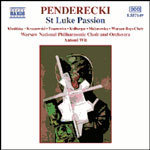
Penderecki: St. Luke Passion
 $25.00
Out of Stock
$25.00
Out of Stock6+ weeks add to cart
KRZYSZTOF PENDERECKI
Penderecki: St. Luke Passion
Izabella Klosinska (soprano) Adam Kruszewski (baritone) Romuald Tesarowics (bass) Jaroslaw Malanowics (organ) / Warsaw National / Antoni Wit
[ Naxos / CD ]
Release Date: Tuesday 20 January 2004
This item is currently out of stock. It may take 6 or more weeks to obtain from when you place your order as this is a specialist product.
"Naxos's Penderecki expert steers a sure, dramatic course through a 1960s classic."
(Gramophone Jan 2004)
Grammy Award Nomination 2005 - Best Choral Performance
Surprising as it now seems, the appearance in 1962 of the Stabat Mater by Krysztof Penderecki caused something of a furore in avant-garde music circles. Coming after radical orchestral works such as Threnody for the Victims of Hiroshima (1961) and Fluorescences (1962) [both Naxos 8.554491], the stark simplicity and emotional directness of the choral piece led, not for the last time in the composer's career, to accusations of being reactionary and turning his back on musical progress. Four decades on, the Stabat Mater can clearly be seen as initiating the consolidation and synthesis that Penderecki was to pursue thereafter, to varying degrees and on different levels.
It is also worth bearing in mind Penderecki's stance, as a progressive composer in the conformist environment of post-Stalinist Poland, and as a devout Catholic in a nominally atheist society. The Stabat Mater was among the first open expressions of faith in Poland since the Second World War, and Penderecki did not hesitate to incorporate it into a more comprehensive expression of his faith when the opportunity arose. In 1964 West German Radio commissioned a large-scale choral work to commemorate the seven hundredth anniversary of the consecration of Munster Cathedral: the Passio et mors Domini nostri Iesu Christi secundum Lucam, to give the St Luke Passion its full Latin title, was the outcome. That the year of its première on 30th March 1966 also marked the thousandth anniversary of the introduction of Christianity into Poland, is a fact of which Penderecki must have been well aware.
Scored for soprano, baritone and bass soloists, narrator, chorus, boys' chorus and orchestra, the St Luke Passion takes as it model the Passions of Bach: the events leading up to the Crucifixion related in an ongoing sequence of narratives, arias and choruses, with the narrator taking the rôle of the Evangelist, and the solo singers assuming those of Christ, Peter, Pilate and other biblical figures as necessary. The text supplements Luke's gospel with a range of extracts from psalms, hymns and antiphons, giving the narrative an emotional force it might otherwise lack. Moreover the diversity of choral and orchestral techniques employed was to prove paradigmatic for the succession of choral works Penderecki has since composed, Dies irae (1967), Kosmagonia (1970), Utrenja (1971), Magnificat (1973), Te Deum (1979), Polish Requiem (1984), Seven Gates of Jerusalem (1996) and Credo (1998).
Part I opens with choir, organ and orchestra defiantly sounding out 'O Crux' at the start of Hymnus [1], sub-divided, microtonal and chanted choral writing contributing to the supplicatory feel. The narrator describes Christ's coming down from the Mount of Olives in Et egressus [2], and the bass expands on his dread in the aria Deus meus [3]. The soprano intensifies the anxiety in the aria Domine, quis habitabit [4], complemented by febrile flute and brass, then lower strings and brass graphically depict the betrayal and taking of Jesus, expounded by baritone and narrator at Adhuc eo loquente [5]. Solemn choral settings from Lamentations at Ierusalem [6], and Psalms at Ut quid, Domine [7], presage Peter's denial at Comprehendentes autem [8]. After an aria of entreaty to the Lord, Iudica me, Domine [9], the mocking before the High Priest is vividly introduced by rushing strings and woodwind, and depicted by rasping chorus at Et viri, qui tenebant illum [10]. The soprano now plangently recalls the imploration to Ierusalem [11], while the chorus looks for mercy in an impassioned Miserere mei, Deus [12]. Part I ends with the scene of Jesus before Pilot at Et surgens omnis [13], narrator, baritone and chorus underpinned by striking orchestration to powerfully dramatic effect.
Part II opens with a sombre choral depiction of the Way of the Cross to Golgotha at In pulverem mortis [14], joined by the narrator at Et baiulens sibi crucem [15], before the sustained passacaglia of Popule meus [16], an emotional highpoint of the Passion and a telling example of Penderecki's deployment of advanced musical techniques to elicit timeless expression. The Crucifixion is simply and movingly depicted at Ibi crucifixerunt eum [17], then unfolded in searching terms by soprano in the aria Crux fidelis [18]. Christ's forgiveness is noted at Dividentes vero [19], then the chorus vividly imagines the humiliation of the body in an extended setting of In pulverem mortis [20]. The mocking of Christ on the Cross is depicted in suitably harsh terms at Et stabat populus [21], then the bass and baritone recall the contrasting responses of the thieves at Unus autem [22] Christ's entreaty to the three Marys at Stabant autem [23] prepares for the extended unaccompanied setting of Stabat Mater [24] an expressive and musical distillation of the emotional charge pervading the whole work. The Death of Christ is summarily depicted at Erat autem fere hora sexta [25], then apostrophized in moving orchestral terms [26], before the Passion draws to a conclusion with In Te, Domine, speravi [27], soloists, chorus and orchestra joining in a powerful call for deliverance and redemption.
- Richard Whitehouse

